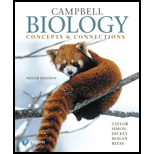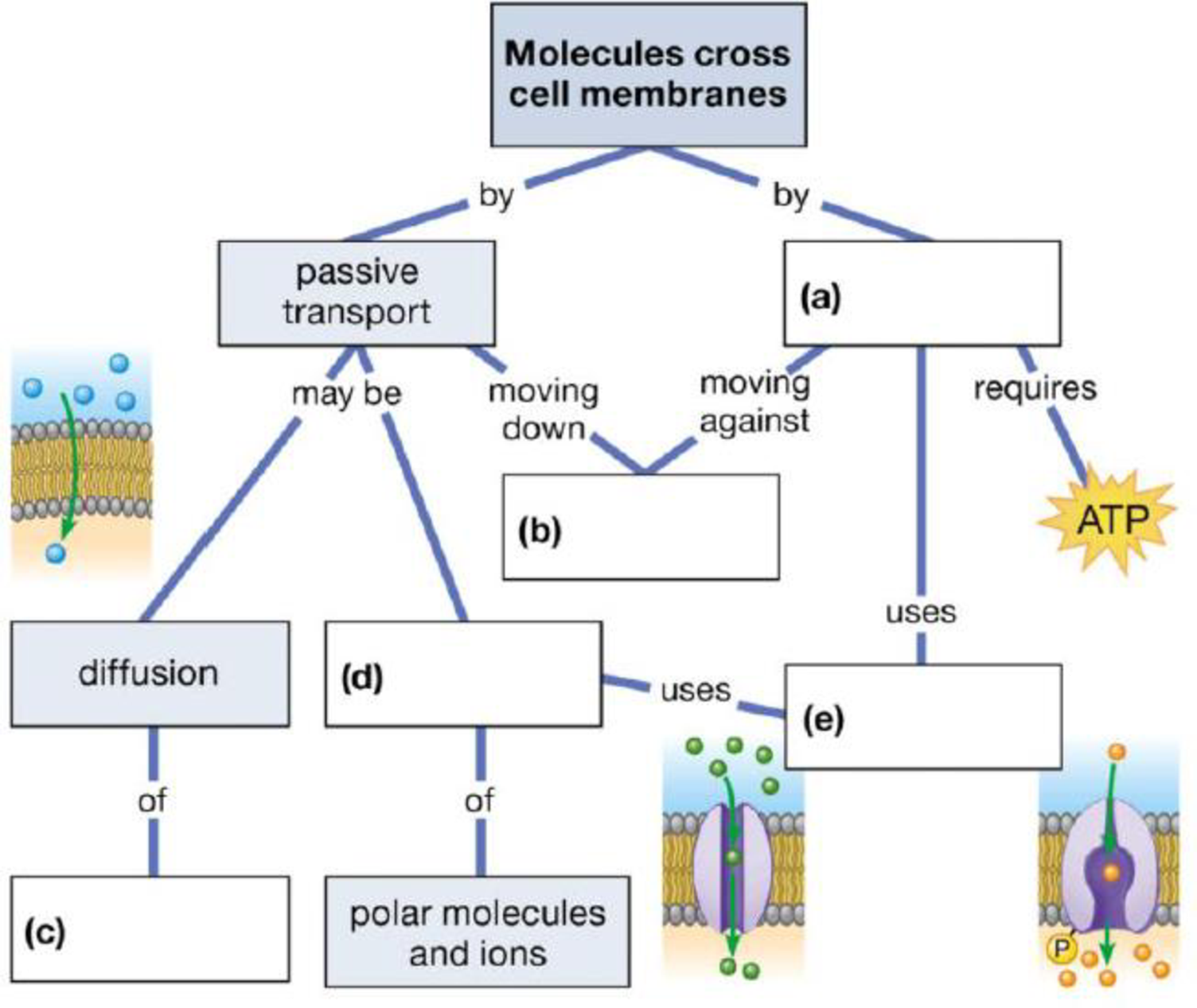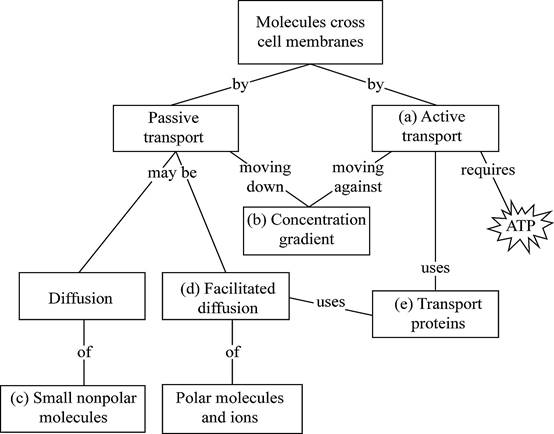
Concept explainers
Fill in the following concept map to review the processes by which molecules move across membranes.

To complete: The given map showing the process by which the molecules move across the cell membrane.
Introduction:
The plasma membrane is selectively permeable, and it allows the movement of substances in and out of the cells. The two main types of transport are active transport and passive transport.
Answer to Problem 1CC
Pictorial representation: The Fig.1 shows the movement of molecules between cells through the cell membranes.

Fig.1: The process involved in the transport of molecules across the cell membrane
Explanation of Solution
(a)
Correct answer: Active transport
Explanation: Active transport is an energy-dependent process in which the molecules are moved from a region of lower concentration to a region of higher concentration against their concentration gradient, and it requires energy in the form of ATP. Hence, the correct answer is Active transport.
(b)
Correct answer: Concentration gradient
Explanation: The concentration gradient is the difference in the concentration of the solutes. Active transport moves the molecules against their concentration gradient, whereas passive transport moves the solutes along with their concentration gradient. Hence, the correct answer is Concentration gradient.
(c)
Correct answer: Small nonpolar molecules
Explanation: A molecule is said to be nonpolar when there is a symmetrical arrangement of polar bonds in a complex molecule or if there is an equal sharing of electrons between the two atoms. These small nonpolar molecules can diffuse across the membrane. Example: Oxygen and carbon dioxide are the two nonpolar molecules that can undergo simple diffusion. Hence, the correct answer is Small nonpolar molecules.
(d)
Correct answer: Facilitated diffusion
Explanation: Facilitated diffusion is a passive transport where the molecules diffuse across the plasma membrane with the help of the membrane proteins such as carriers and channels. This transport does not require energy, and it moves the solute down the concentration gradient. Hence, the correct answer is Facilitated diffusion.
(e)
Correct answer: Transport proteins
Explanation: Transport proteins are a type of proteins used to move the substances across the cell membrane. They are mainly of two types: channel proteins and carrier proteins. Channel proteins are used to transport ions in and out of the cell, and carrier proteins are used to transport macromolecules, ions, and small molecules by changing their shape or conformation. Hence, the correct answer is Transport proteins.
Want to see more full solutions like this?
Chapter 5 Solutions
Campbell Biology: Concepts & Connections (9th Edition)
- Describe the types of noncovalent interaction that promote the stability and functional properties of biological membranes.arrow_forwardBiological membranes are critical components of cells that allow compartmentalisation of cellular contents. The diagram shows a biological membrane comprised of a lipid bilayer with a single polypeptide integrated into the membrane and spanning the membrane seven times. What types of amino acids are likely present in the parts of the polypeptide chain labelled 1-7 and in the parts of labelled A-G? What is the name of the effect that forces the polypeptide to arrange itself like this within the lipid bilayer? Give an example of a type of molecule that can move freely across the lipid bilayer and explain why it can do so based on its chemical properties.arrow_forwardDescribe the fluid-mosaic model of membrane structure.arrow_forward
- An artificial cell consisting of an aqueous solution enclosed in a selectively permeable membrane (but with no cell wall) is immersed in a beaker containing an aqueous solution. The outside environment concentration consists of 0.01 M glucose and the inside of the cell has a concentration of 5.0 M glucose. The plasma membrane is permeable to water and monosaccharides, but impermeable to the disaccharides. Complete the following for the image below: Is the glucose going down or against its concentration gradient? Is the movement of the solute in the cell going out of the cell? Down...Yes Down...No Against...Yes Against...Noarrow_forwardDraw and label a cell lipid bilayer and diagram how the following transport processes take place: passive diffusion of oxygen into the cell, facilitated diffusion of potassium into the cell, active transport of sucrose into the cell. Using different symbols (circles for oxygen, squares for sucrose, and triangles for potassium ions), show the relative concentrations (gradients) of these substances on the inside and outside of the cell. For example, to show that oxygen enters the cell by going “down” its gradient, you would draw more circles on the outside of the cell than inside the cell. Be sure to show and label membrane proteins when appropriate, and show the electric membrane potential using “+”s (pluses) on one side and “-”s (minuses) on the other side of the membrane. Also show the proton pump which uses ATP as a source of energy.arrow_forwardWhich of the following is true about motion of membrane lipids? A. They can move most rapidly when in the gel phase. B. Lateral diffusion is catalyzed by flippase proteins. C. To increase the fluidity of membranes at low temperatures, cells synthesize more saturated fatty acids and fewer unsaturated fatty acids. D. Transbilayer diffusion involves the transfer of lipids from one face of the bilayer to another.arrow_forward
- Below are listed molecules with different chemical characteristics. Knowing that all molecules will eventually diffuse across a phospholipid bilayer, select the list that most accurately predicts the relative rates of diffusion of these molecules (fastest to slowest) across a biological membrane. alanine, propanol, sodium, estrogen sodium, propanol, alanine, estrogen estrogen, propanol, sodium, alanine estrogen, propanol, alanine, sodiumarrow_forwardWhich of the following best describes the pH of the lysosomal interior? a.) The interior of a lysosome generally has a pH similar to cytoplasm b.) The interior of a lysosome generally has a pH higher than cytoplasm c.) The interior of a lysosome generally has a pH lower than cytoplasmarrow_forwardWhile performing fluorescent microscopy to observe the transport of bulk molecules into a cell a researcher uses a green, fluorescent bulk protein and a red fluorescent dye to stain the cell membrane. If the cell has the ability to transport the bulk proteins into the cell, what would we expect to see in the microscope when the images are merged? What would we expect to see if the cell did not have the ability to transport the bulk protein?arrow_forward
- Eukaryotic membrane fluidity can be increased by which of the following mechanisms? increasing the number of carbons in the fatty acids of membrane lipids increasing the number of fatty acids attached to glycerol in membrane lipids increasing the number of straight-chain fatty acids of membrane lipids increasing the degree of unsaturation in the fatty acids of membrane lipids increasing the number of membraned organelles in the eukaryotic cellarrow_forwardPractitioners of naturopathic medicine often use “essential oils” such as lavender oil. (Note that essential refers to their essence or scent and does not imply that these substances are necessary for health.) One of the components of lavender oil is shown below. Based on its structure, could this molecule diffuse through the cell membrane of a skin cell after the oil was applied to the skin surface?arrow_forwardEukaryotic membrane fluidity can be increased by which of the following mechanisms? cell bio increasing the number of carbons in the fatty acids of membrane lipids increasing the number of fatty acids attached to glycerol in membrane lipids increasing the number of straight-chain fatty acids of membrane lipids increasing the degree of unsaturation in the fatty acids of membrane lipids increasing the number of membraned organelles in the eukaryotic cellarrow_forward
 Human Anatomy & Physiology (11th Edition)BiologyISBN:9780134580999Author:Elaine N. Marieb, Katja N. HoehnPublisher:PEARSON
Human Anatomy & Physiology (11th Edition)BiologyISBN:9780134580999Author:Elaine N. Marieb, Katja N. HoehnPublisher:PEARSON Biology 2eBiologyISBN:9781947172517Author:Matthew Douglas, Jung Choi, Mary Ann ClarkPublisher:OpenStax
Biology 2eBiologyISBN:9781947172517Author:Matthew Douglas, Jung Choi, Mary Ann ClarkPublisher:OpenStax Anatomy & PhysiologyBiologyISBN:9781259398629Author:McKinley, Michael P., O'loughlin, Valerie Dean, Bidle, Theresa StouterPublisher:Mcgraw Hill Education,
Anatomy & PhysiologyBiologyISBN:9781259398629Author:McKinley, Michael P., O'loughlin, Valerie Dean, Bidle, Theresa StouterPublisher:Mcgraw Hill Education, Molecular Biology of the Cell (Sixth Edition)BiologyISBN:9780815344322Author:Bruce Alberts, Alexander D. Johnson, Julian Lewis, David Morgan, Martin Raff, Keith Roberts, Peter WalterPublisher:W. W. Norton & Company
Molecular Biology of the Cell (Sixth Edition)BiologyISBN:9780815344322Author:Bruce Alberts, Alexander D. Johnson, Julian Lewis, David Morgan, Martin Raff, Keith Roberts, Peter WalterPublisher:W. W. Norton & Company Laboratory Manual For Human Anatomy & PhysiologyBiologyISBN:9781260159363Author:Martin, Terry R., Prentice-craver, CynthiaPublisher:McGraw-Hill Publishing Co.
Laboratory Manual For Human Anatomy & PhysiologyBiologyISBN:9781260159363Author:Martin, Terry R., Prentice-craver, CynthiaPublisher:McGraw-Hill Publishing Co. Inquiry Into Life (16th Edition)BiologyISBN:9781260231700Author:Sylvia S. Mader, Michael WindelspechtPublisher:McGraw Hill Education
Inquiry Into Life (16th Edition)BiologyISBN:9781260231700Author:Sylvia S. Mader, Michael WindelspechtPublisher:McGraw Hill Education





